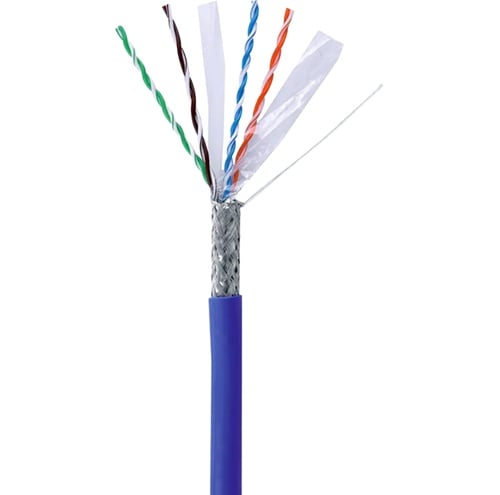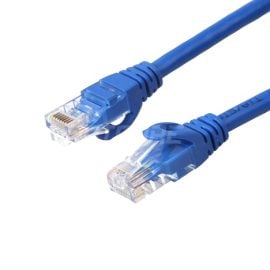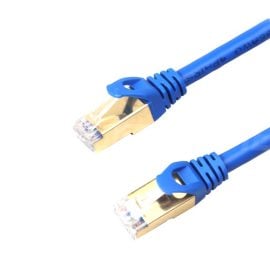Network Cabling, Networking Device
UTP vs. STP vs. FTP vs. S/FTP Cable, What is The Difference
When it comes to network cabling systems, you need to choose the suitable ethernet cable among the different types. One of the critical considerations is the level of shielding, like UTP, STP, FTP, SFTP, and so on. Today, we’ll look at their differences and how you might choose them.
Table of Contents
- What is UTP cable?
- What is STP cable?
- What is FTP cable?
- What is S/FTP cable?
- UTP vs. STP vs. FTP vs. S/FTP
- FAQs
- Conclusion
What is a UTP cable?
UTP stands for unshielded twisted pair. It is the most common and most basic type of twisted pair cable. The UTP cable contains twisted wire pairs that help to decrease and prevent electromagnetic interference. Because the UTP cable has no shielding, it provides many advantages like lower cost, easy installation, and maintenance. As a result, they are a popular choice for small and medium-sized networks.

What is an STP cable?
STP stands for shielded twisted pair. Unlike the UTP cables, STP cables cover with a shielding or screening material that consists of foil wrapping or a copper braid jacket.

In contrast to UTP, STP require the use of a grounding cable. Shielded Twisted Pair (STP) requires significantly more maintenance than Unshielded Twisted Pair (UTP), making it more expensive.
STP metal shield provides enhanced protection against electromagnetic interference. More importantly, it offers better performance for crosstalk-intensive application scenarios. Hence, STP cable is widely used in high-bandwidth networks like radio stations and airports.
Although it has the above advantages, STP cable also has disadvantages, such as more complexity in installation and maintenance and higher cost.
What is an FTP cable?
FTP stands for foil twisted pairs. Each FTP cable is shielded with an overall foil tape shield around the assembly to protect it from EMI and crosstalk. Sometimes, FTP is also referred to as F/UTP.

Compared to UTP, FTP cable has higher bandwidth and is more resistant to interference, but it costs more and has slightly less bending performance.
What is S/FTP cable?
S/FTP means shielded foil twisted pair. It is double shielded twisted pair cable, with an additional layer of braided mesh on top of the STP. It is commonly used as a braided mesh of aluminum-magnesium wire. Still, it is also used as tin or tinned copper wire, making it resistant to interference and highly confidential for professional cabling projects.

UTP vs. STP vs. FTP vs. S/FTP Cable, What is The Difference?
We know the meaning of different ethernet cables. Now let us make a complete comparison of UTP vs. STP vs. FTP vs. S/FTP Cable. The below table lists their difference.
| Comparison | UTP | STP | FTP | S/FTP |
| Full Name | Unshielded twisted pair | Shielded twisted pair | Foil twisted pairs | Shielded foil twisted pairs |
| Cable Shield | None | Braiding | Foil | Braiding |
| Twisted Pair Shield | None | None | None | Foil |
| Crosstalk | High crosstalk | Low crosstalk | Low crosstalk | Low crosstalk |
| Termination | Easier to terminate and saves time | Difficult and takes a longer time | Difficult and takes a longer time | Difficult and takes longest time |
| Bonding and Grounding | Not required | Necessary | Necessary | Necessary |
| Data rate | Low | High | High | High |
| Application | Home network | Longer distance network | Longer distance network | Longer distance network |
| Costs | Cheaper and does not require much maintenance | Moderately expensive | Moderately expensive | Very expensive |
FAQ
Here are some common questions about UTP vs. STP vs. FTP vs. S/FTP Cable.
Q: Is STP better than UTP?
A: In terms of performance alone, STP is better. Because STP has an additional mesh shield, which protects the cable from electromagnetic interference and eliminates crosstalk, the extra shielding also allows STP to deliver higher data rates than UTP. Therefore, STP is often used in crosstalk-sensitive data transmission networks, for example, networks that can significantly impact data transmission.
However, the additional shielding of STP adds to the cost and difficulty of installation. However, UTP is more cost-effective and easier to install and maintain, as it has no shielding. UTP cable is a better choice for general home and business networks.
Q: How to ground STP cable?
The STP cable’s aggregation (networking equipment) side should be grounded. It is important to note that grounding must be done only at one cable end, not both. If you are terminating cabling with patch panels, the optimum application would be to attach cable grounds to the patch panel and ground the panel itself. There are dedicated panels for this purpose.
Q: What is the most typical difficulty with UTP cable?
A: Crosstalk is the most typical difficulty for UTP cable. Generally, Crosstalk is more common in older types of UTP cable (for example, Category 3 or 5) than in newer versions such as Cat5e or Cat6.
Q: Do all UTP cables support PoE?
A: No. It is mainly based on other cable types—only Cat5 or higher grade cable support PoE.
Final Words
Now that you’ve read these twist cable guides and comparisons, you should know their differences.
Are you clear about their application?
Do you know their different advantage and weakness?
Please leave your comments and let us know.
Reference:
Read more:
- PoE Ethernet Switch vs. PoE Router vs. PoE Media Converter vs. PoE Injector vs. PoE Splitter Comparison
- A Quick Guide to 10G Fiber Media Converter
- Teardown Report: OPTCORE SFP to Ethernet Media Converter
- What’s the Best Fiber Media Converter for Home & Home Office Use?

 Español
Español 日本語
日本語









Ver good and simple words information. Very Nice. Thankyou